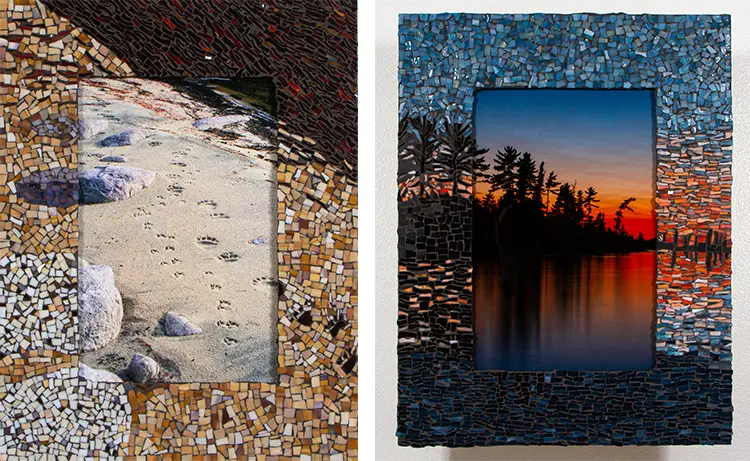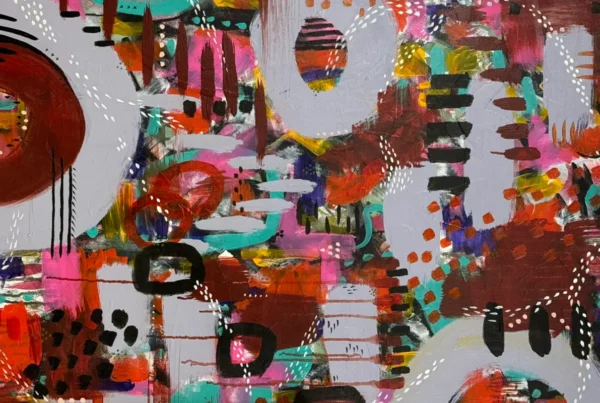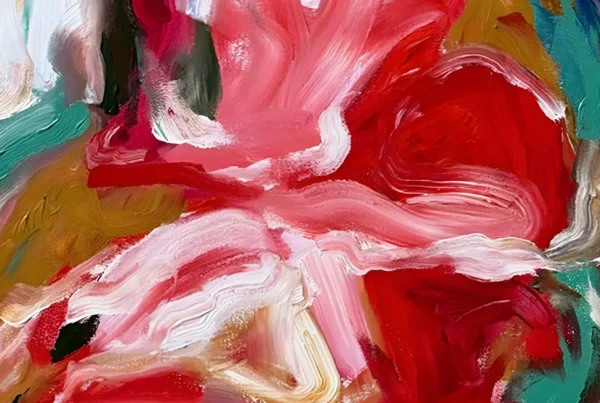“Art heals the mind, body, and soul. By creating Photozaics, I hope to connect with you through a multi-sensory experience that tickles sight and encourages your touch.”
Nature, Nostalgia, and the Eye of a Wanderer
Growing up in Saint Paul, Minnesota, Natalie McGuire found herself surrounded by a quiet yet rich intersection of heritage and geography. With her mother’s German roots and her father’s Minnesotan lineage grounding her in dual cultural perspectives, Natalie’s early life unfolded amid a blend of tradition and exploration. Though she remains based in her hometown, she treasures the city’s intimacy and strategic location that makes it ideal for her travel-based creative pursuits. Her childhood was shaped by RV trips across the country with her family, experiences that allowed her to absorb the subtleties of the American landscape not from 30,000 feet in the air but from roadside vistas and winding backroads. These formative journeys were not just about reaching a destination but about observing the living, breathing world as it passed by—views that would one day be refracted through glass and camera lens.
A deep appreciation for the natural world took hold early, inspired in part by watching Ansel Adams’ stark yet poetic landscapes and Bob Ross’ soothing televised sessions of painted serenity. Though Ross worked in paint, the emotional resonance of his work stayed with Natalie. His meditative approach mirrored what she later discovered in her own practice—that art could be a portal into peace, connection, and healing. It was during those long road trips, with no distractions beyond the changing scenery, that her imagination was first lit. The endless horizon became her screen, offering a visual narrative that demanded stillness, observation, and imagination.
Saint Paul and the surrounding Midwest continue to offer her a varied visual library: sprawling cities that give way to narrow rural roads, lakes that hold light like a mirror, rivers that hum with their own rhythm, and the looming quiet of the Great Lakes. It is in this expansive yet intimate geography that Natalie’s artistic vision took root. Each outing into these landscapes is not only an exploration but a conversation between artist and earth—a dialogue that shapes the heart of her work.
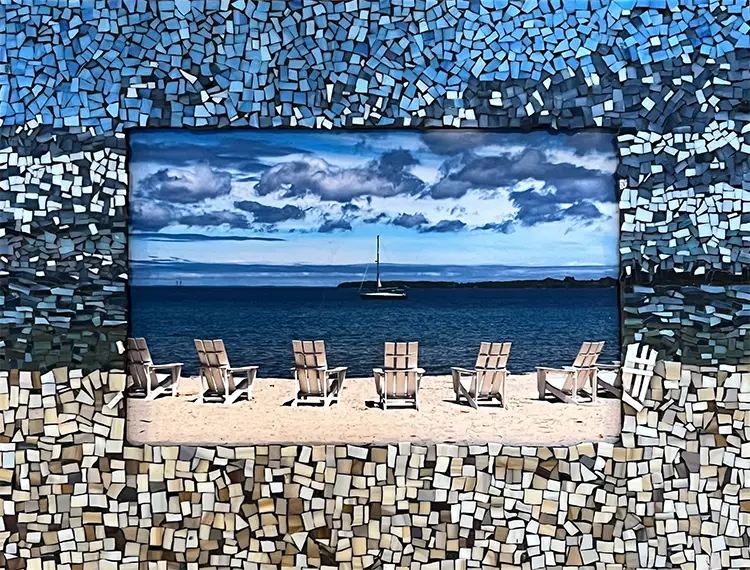
Natalie McGuire: Where Photography Meets Mosaic Poetry
At the core of Natalie McGuire’s artistic practice lies her signature technique: Photozaics. These works do not merely document landscapes—they reconstruct them through an intricate and tactile process that transforms photographs into dimensional mosaics framed by hand-cut stained glass. Inspired by the textural emotion of Van Gogh, the minimalist brilliance of Ansel Adams, and the therapeutic calmness of Bob Ross, Photozaics fuse visual storytelling with physical craftsmanship. Each piece begins in the wilderness, where Natalie photographs scenes that stir something within her. Whether it’s a rustling creek or the curve of a hill under golden light, she captures not just an image but an atmosphere.
Once the photograph is selected, the transformation begins. Natalie sources stained glass to mirror the color palette of the image, seeking hues that echo the mood and texture of the original scene. The glass is shaped using a combination of hand-sanding for larger pieces and a rock tumbler for the finer shards, ensuring smooth edges that maintain the visual harmony of the work. Each piece is positioned deliberately, and once arranged, the entire composition is grouted—a stage that heightens the textural contrast and draws attention to the interplay between photo and frame. The result is a multisensory experience, inviting the viewer not only to look but to linger and feel.
Natalie’s intent is not simply to recreate nature, but to evoke the emotional landscapes within the viewer. Her exhibitions aim to provide more than aesthetic pleasure; they offer restoration. Research suggesting the therapeutic impact of engaging with art underpins her mission, and Natalie crafts each Photozaic as a healing encounter. She envisions these framed scenes as portals—an invitation to step beyond stress, into a meditative space where nature’s quiet voice can be heard again. Her belief that art should be touched, felt, and internalized is evident in the layered complexity of her work, where stained glass becomes more than decoration—it becomes emotion solidified.
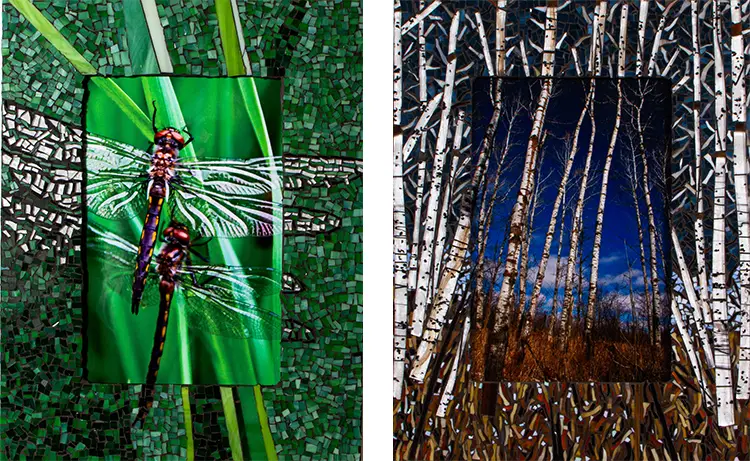
Textures of Memory and Meaning
The emotional power of Natalie McGuire’s work reaches beyond technique, resonating on a deeply personal level for many who encounter it. One piece in particular, Alone in the Fog, stands out in her journey as an artist. Captured on Mother’s Day, the image features a dock enveloped in mist, set against a placid lake. The composition is sparse, yet hauntingly poignant, evoking themes of solitude, stillness, and transition. During an exhibition where this piece was shown, a viewer became visibly moved after reading the accompanying story. When she confirmed that her mother had passed on that exact day, the photograph suddenly became more than an artwork—it became a vessel of shared mourning and emotional recognition. That moment, for Natalie, reaffirmed her core belief that art has the power to reach people in places words cannot.
The quietude of Alone in the Fog carries a poetic stillness that mirrors Natalie’s broader philosophy. She sees fog not as an obstacle but as an enhancer of beauty, quoting Mehmet Murat Ildan: “In nature, everything has a job. The job of the fog is to beautify further the existing beauties.” This mindset informs her artistic decisions. She welcomes ambiguity, subtlety, and quiet grandeur, choosing scenes that hold emotional tension in their stillness. Her works often explore this balance between presence and absence, between visibility and veiling, inviting viewers to bring their own interpretations.
In each piece, Natalie constructs a multi-layered experience. The mosaic frames do not simply border the images; they extend the narrative outward. These frames encourage a curiosity about what lies beyond the visual field, engaging the viewer not only with what they see but with what they sense. Whether it is the shimmer of lake water rendered in stained glass or the abstraction of trees fading into fog, Natalie’s work prompts reflection. It transforms static observation into dynamic introspection, offering moments that live far beyond the gallery walls.
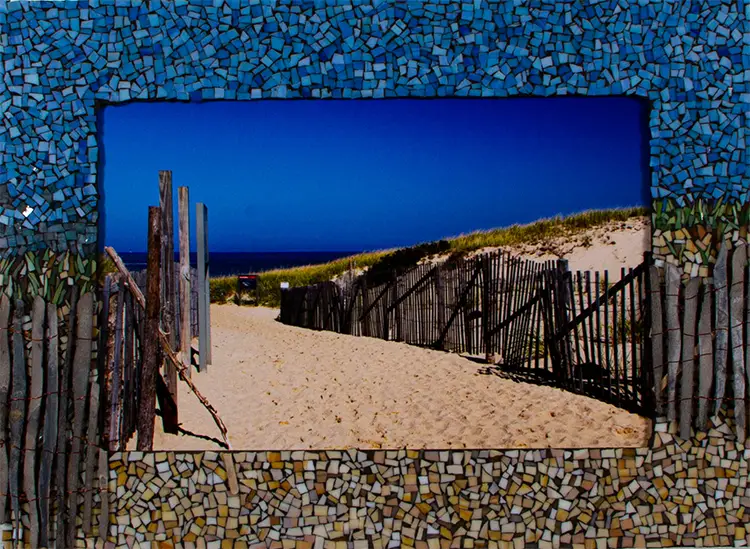
Natalie McGuire: Crafting Consciousness from Shards and Shadows
In her daily practice, Natalie approaches each creative session with openness, guided more by intuition than rigid planning. With cameras in hand, she steps into nature without predetermined goals, allowing the landscape itself to suggest its stories. This collaborative process with the environment forms the first stage of what she calls her “commando Photozaics”—a term she uses to describe her dynamic blend of fine art photography and sculptural mosaic frames. Each piece she creates is unique, not only in subject matter but in the demands it places on her craftsmanship, creativity, and problem-solving instincts.
Natalie’s creative toolkit extends beyond traditional materials. She often integrates unconventional elements such as glass rods, wooden sticks, and even everyday items like popsicle sticks to achieve specific visual effects. For instance, in one Photozaic featuring the Golden Gate Bridge, she placed glass rods directly atop the grouted surface to emphasize the bridge’s structure. In another, she arranged cut sticks to simulate rustic fence posts or rocky textures, blurring the line between photograph and sculpture. These additions enrich the narrative of the work, providing tactile detail that echoes the natural world she seeks to interpret. Each layer serves not just as embellishment but as a deliberate deepening of the viewer’s engagement.
Looking ahead, Natalie is eager to expand the scope of her practice, not only through new landscapes but also through more immersive exhibition experiences. She envisions future projects where her work surrounds the viewer completely, creating environments that not only display her art but embody its message of healing and reconnection. Whether experimenting with new materials or revisiting familiar terrains with fresh eyes, Natalie remains committed to pushing the boundaries of what visual art can be. Her work stands as a testament to the enduring relationship between the human spirit and the natural world—a conversation captured one shard of glass, one photograph at a time.
